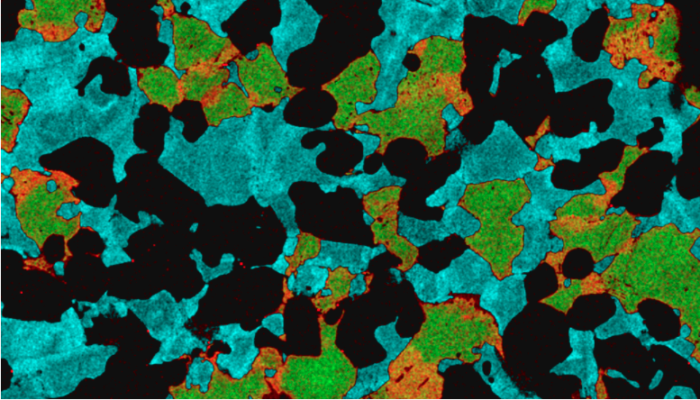The next “Minds over Methods” blogpost is a group effort of Liene Spruženiece (left) – postdoctoral researcher at RWTH Aachen and her colleagues Joyce Schmatz, Simon Virgo and Janos L. Urai. The Virtual Microscope is a collaborative project between RWTH Aachen University and Fraunhofer Institute for Applied Information Technology (Schmatz et al., 2010; Virgo et al., 2016). In the ...[Read More]
Natural Hazards
The proliferation of Cyanobacterial blooms: A toxic blue tide
Dr Assaf Sukenik is Senior Scientist at Kinneret Limnological Laboratory of the Israel Oceanographic and Limnological Research. His research interests concern the physiology and biochemistry of freshwater and marine algae, Cyanobacteria and algal toxins, the water quality of freshwater ecosystems. What are cyanobacteria and what is their natural habitat? Cyanobacteria (from the Greek word κυανοσ = ...[Read More]
Cryospheric Sciences
Did you know? – Storms can make Arctic sea ice disappear even faster
The increase in air and water temperature due to climate change drives the retreat in the Arctic sea-ice cover. During summer, when sunlight reaches the Arctic, the absorption of heat by the dark ocean water enhances the sea-ice melt through the ice-albedo feedback. During winter, when sunlight does not reach the Arctic, another feedback is at work, as storms enhance the energy transfer between ai ...[Read More]
Geodynamics
The Sassy Scientist – Jekyll and Hyde
Every week, The Sassy Scientist answers a question on geodynamics, related topics, academic life, the universe or anything in between with a healthy dose of sarcasm. Do you have a question for The Sassy Scientist? Submit your question here. Senna asks: I’m torn between mantle dynamics and lithosphere dynamics as a research topic. Which shall I choose? Dear Senna, Could you follow my little Jekyll ...[Read More]
Seismology
Seismology Job Portal
On this page we regularly update open positions in Seismology. Do you have a job on offer? Contact us at ecs-sm@egu.eu
Geochemistry, Mineralogy, Petrology & Volcanology
Are mantle melts heterogeneous on a centimeter scale?
The mantle makes up the majority of the volume of the Earth, but there is still a lot about it that we don’t understand. This is because we can’t observe it directly – forget ‘Journey to the center of the Earth’ – even our deepest drill holes (about 12 km deep) are merely tickling the surface of the planet (about 6400 km to the center). Most of what we know abou ...[Read More]
Tectonics and Structural Geology
From Mountains to Modernists: the geological foundations and inspirations of Barcelona
Barcelona is a vibrant city on the Mediterranean coast, nested snugly between the sea and the Collserola Ridge of the Catalan Coastal ranges. The story of Barcelona starts around 2000 years ago as an Iberian settlement, owing to its strategic location on the coastal route connecting Iberia and Europe. The combination of easily defendable ground and the fertile soils of the Besos and Llobregat delt ...[Read More]
Geodynamics
Let’s talk about plagiarism
Hey you! Do you have 5 minutes to talk about plagiarism? Have you ever wondered if some parts of a thesis that you have supervised are simply a copy-paste from another thesis or article? This week, an anonymous guest author will tell us about their personal experience with plagiarism in science and what can be done against it. Granted, it is not the most fascinating topic. Until recently, I really ...[Read More]
Hydrological Sciences
Talking hydrology: an interview with Hjalmar Laudon on hydrological research at the Krycklan catchment
For our second post of “Talking hydrology”, we interviewed Hjalmar Laudon, professor and chair of forest landscape biogeochemistry at SLU Umeå (Sweden). We talked about past and current research in the Krycklan catchment and the usefulness of long-term datasets. 1) You have been conducting hydrological research at the Krycklan catchment (North of Sweden) since 2002. How did you keep yoursel ...[Read More]
Geochemistry, Mineralogy, Petrology & Volcanology
#mineralmonday : lithiophilite
What is it? Lithiophilite, LiMnPO4 What’s it made of? Lithium (Li), manganese (Mn), phosphorus (P) and oxygen (O). The PO4 at the end of the formula makes this a phosphate mineral (phosphorus + oxygen = phosphate). What’s it’s structure? The way the different atoms are arranged in lithiophilite is described as orthorhombic, which means the crystal is built of lots of tiny cuboid- ...[Read More]









